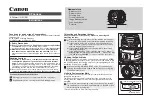
Enabling the electronic sensitivity boosting function causes the following
:
The exposure time of the camera's image sensing device will be increased automatically in dark
situations. This may result in conspicuous afterimages, blurs, and white spots if the subject
includes any moving object.
If [DAY/NIGHT] is set to “AUTO”, the electronic sensitivity boosting function will work only for
black/white video images.
The electronic iris (EI) setting will be cancelled.
[SHUTTER] is set to “OFF”, preventing you from configuring the electronic shutter setting
(“SHORT” or “LONG”).
3
In [LEVEL], select the video signal level and click
SET
.
0 (dark) to 100 (bright)
The electronic iris (EI) function cannot be used in conjunction with the auto iris function.
If you have decided to use the electronic iris, configure the lens iris manually using the following procedure.
1
In [IRIS], select “MANUAL”.
2
In [EI], enable or disable the electronic iris.
Adjusts the exposure, controlling both the AGC circuit and the shutter speed.
OFF: Disables the electronic iris.
ON: Enables the electronic iris.
Enabling the electronic iris (EI) function causes the following:
The electronic shutter setting (SHORT/LONG) will be cancelled and the electronic sensitivity
boosting will not work.
Under extremely bright lighting, the electronic iris function cannot adjust the light entering the lens,
resulting in a phenomenon such as a smear. This may be prevented by adjusting the lighting angle
or other measures.
Under fluorescent lighting, the camera may cause the target image to flicker. To prevent this,
replace the fluorescent lamps with incandescent lamps.
3
In [IRIS STOP], select the value to adjust the lens iris.
The lens iris opens or closes based on the iris stop setting.
1 (closes the iris = dark) to 17 (opens the iris = bright)
4
In [LEVEL], select the video signal level and click
SET
.
0 (dark) to 100 (bright)
Working with Administrator Configuration Screens 23/77
















































